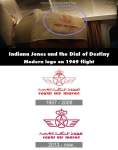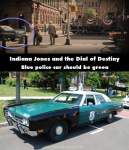Factual error: The Major that salutes Colonel Weber next to the train, credited as Gestapo Officer, has the SS runes on his neck instead of a black square. (00:05:25)
Factual error: The four-barrelled Flak gun is shown running out of ammunition, namely a belt of rounds. This is most likely intended to be a Flak 38, which used twenty-round magazines, not belts. It had a relatively low rate of fire as the magazines had to be constantly swapped out, and two barrels were usually fired at a time. (00:16:58)
Factual error: Whilst Indy and friends dive the Roman shipwreck, they descend and ascend rapidly to and from the sea floor. The conventional method to dive at depth is to descend slowly - to equalise your pressure, as well as to ascend slowly - once more to equalise for the pressure differences. The 3-minute dive duration, with rapid descents and ascent, simply is not possible without the effect of causing serious trauma to the body. (01:09:30 - 01:14:50)
Factual error: The night before Indy dives on the Roman wreck, his co-star describes the plan. An initial 70ft drop, followed by a further 300ft descent to the sea floor. Essentially, if you breathe compressed air to equalise your lungs to the surrounding pressure, then you cannot ascend to the surface rapidly from that depth. Breathing normal air, you can suffer from oxygen toxicity at around 56m. Due to the partial pressure law, at 370ft/112m, you would need a heliox mix (10% oxygen) from a second tank to survive. (01:21:00 - 01:22:08)
Factual error: While in Siracusa, there is a puppet show which features the music of the soundtrack from the movie Amarcord, by Federico Fellini (music by Nino Rota). The scene takes place in 1969, whereas Amarcord and its soundtrack appeared in 1973.
Factual error: When flying towards the time fissure, the German commander says that Hitler is awaiting info on the V-1 project. They're supposed to be heading for a date shortly before Germany invaded Poland. The V-1 project started in early 1942, and it wasn't named the "V-1" until June 1944.
Factual error: Basil Shaw is British, but the dates in his notes about the Antikythera are all written in American format (MM-DD-YY), as opposed to DD-MM-YY.

Factual error: Indy wakes up and has a bottle of Vicodin Es next to him, which was not introduced in the US until 1978, 9 years after the movie is set.
Factual error: The Siege of Syracuse occurred in 212 BC, during the Second Punic War, when Rome was still a republic. Some of the equipment the Romans are using in the movie, however, particularly their swords and helmets, are replicas of weapons dating to the later Imperial era.
Factual error: The German SS soldiers salute superior officers with "Sieg Heil!", which means, "Hail Victory." The proper salute would have been "Heil Hitler!", which was required for all branches of the German armed forces after the July 20th, 1944 bomb plot against Hitler.
Factual error: Shaunette Renée Wilson's (Agent Mason's) costume isn't right for 1969. That specific type of colored leather jacket, eyeglass shape, and long collared blouse in that style of geometric print didn't start being worn that way until the early 1970s.
Factual error: When Indy wakes up on the day of New York City's parade for the Apollo 11 astronauts, H.R. Pufnstuf is on the television. The parade was held August 13, 1969, but H.R. Pufnstuf didn't premiere until September 6, 1969.

Factual error: The crown on the logo of the Air Maroc plane is the modern 2013 version, not the one from 1969 when the movie is set.

Factual error: When Jones and Shaw rans out of the Hotel back alley in Tanger, there's a modern Scooter moped with 5-spoke plastic wheels.
Factual error: In the prelude scene, when Indy enters the car where a number of German soldiers are having supper, the latter are singing "Lili Marleen", a popular soldier's song in the 1940s. The only problem here is that the song was banned in Nazi Germany from 1942 after its last performer, Lale Andersen, was found to have sympathized with Jews. With common soldiers singing it while a strict officer might burst in among them at any time, it would have meant extremely harsh penalties for them.

Factual error: All of the police cars in New York City are painted in a blue and white livery, but until 1973, NYPD cars were painted black, white, and green.
Factual error: Colonel Weber is not an Oberst, but an SS-Oberführer. Given all his men are also SS, there is no likelihood they would use an army rank to address him, especially one that is junior to his actual rank.
Suggested correction: In fact, Oberst is the literal translation of the word "Colonel" into German. It would not be unusual for Germans to call a colonel by his rank in his native language (even if he is an SS colonel).
There is no chance that SS men would use an army rank when referring to an SS officer. That would be like a sailor calling a naval captain "colonel" because the ranks are equivalent.
Factual error: The cutscene when Indy travels to Morocco shows a clip of a train traveling at high speed through the desert. These are actually Belgian-manufactured trains and didn't operate in Morocco until around 1990, while the film's plot takes place in 1969.
Factual error: The plunder train is revealed to have travelled through the French Alps, when it was captured by the British. However, this would've meant the train was travelling through areas that still would've been under the Vichy regime. Most of these areas, while they did face Allied bombing, were liberated by French troops, not British. (The British and Americans were more concerned with heading for Germany).





